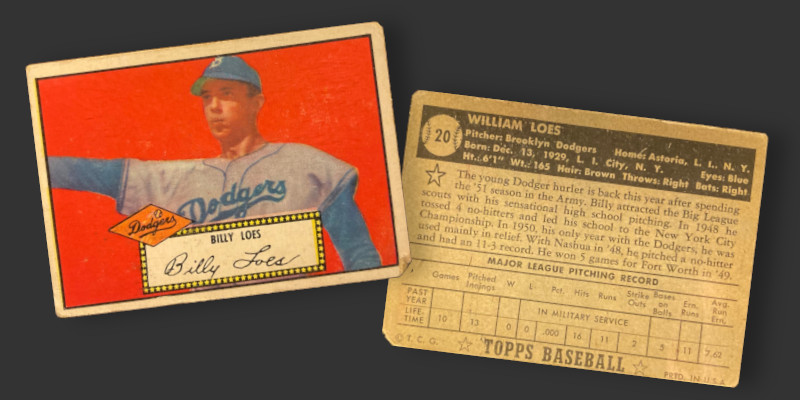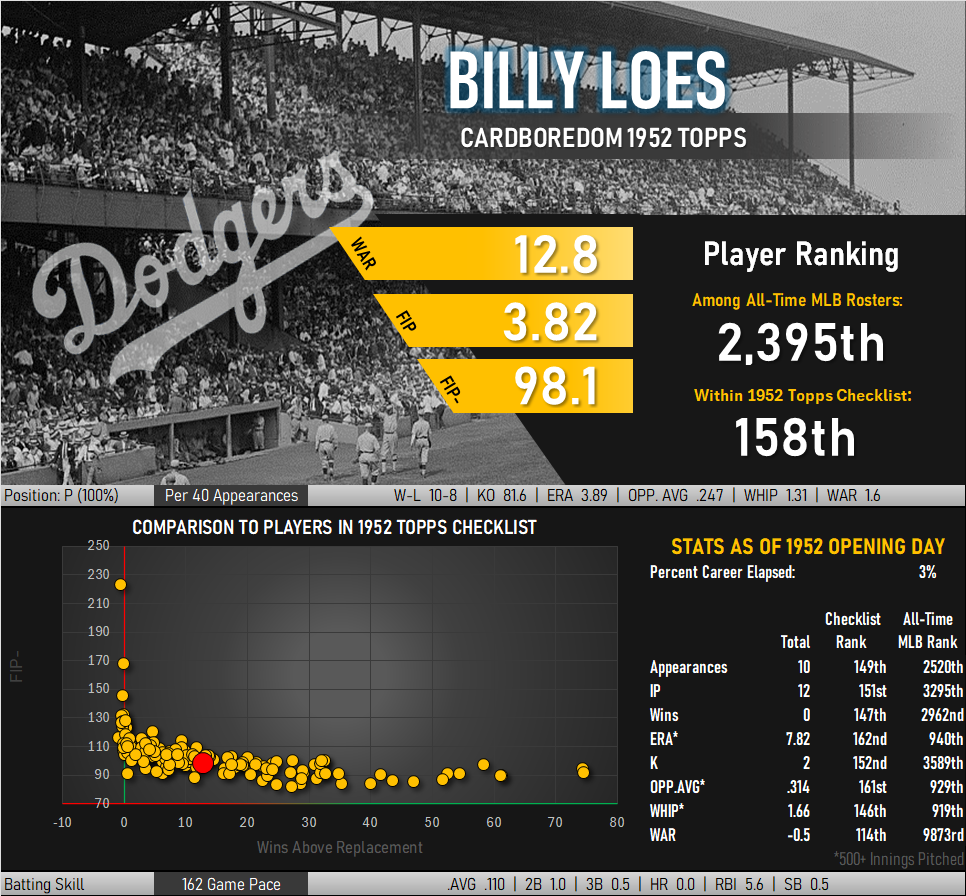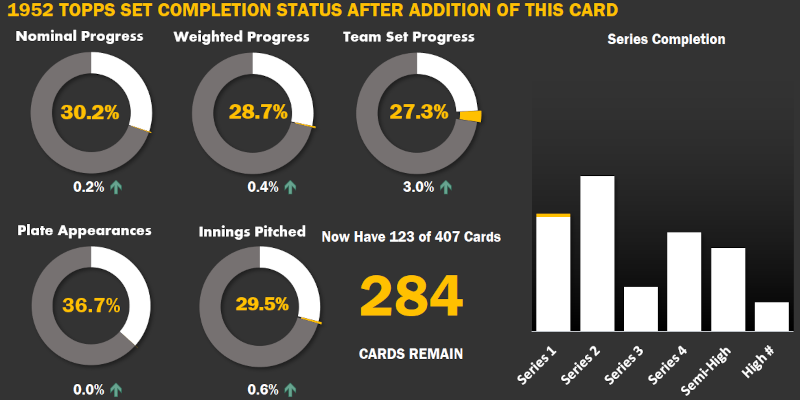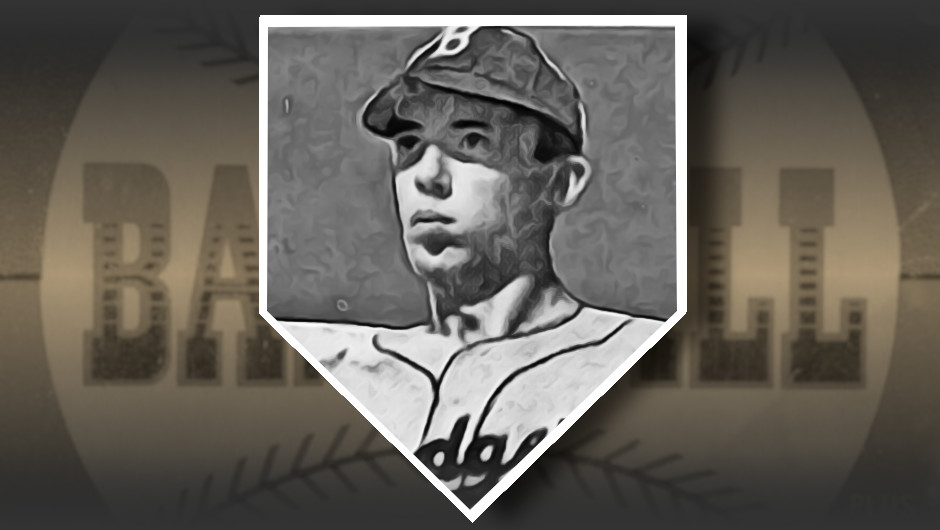There’s a lot to unpack when it comes to Billy Loes and the 1952 Topps set. Always an odd duck, Loes reminded a lot of people of the antics of Dizzy Dean. He went to high school with Whitey Ford in Brooklyn and ended up being signed as a “Bonus Baby” to play for his hometown Dodgers. At the time, MLB rules required recipients of bonus payments to remain with the top level club for a period of time before they could be reassigned to minor league teams. Not yet ready for the majors, the young (and outspoken) Loes threw up a 7.52 ERA in his first 10 games.
The US Army took him off Brooklyn’s hands for the 1951 season and returned him in time to begin the 1952 campaign. Brooklyn-based Topps was waiting for the return of their hometown hero and included Loes’ rookie in its first series of 1952 cards. He didn’t disappoint, spinning four shutouts while generating a 2.69 ERA on the way to the World Series.
Already familiar with the quirks of Loes’ personality, Topps might have used this card as an opportunity to play a joke. Often described as “weird” or “screwy,” Loes often gave Yogi Berra-esque answers to reporters’ questions. In the ’52 set, Topps placed card numbers inside a baseball on the upper left corner of card backs. The seams of the ball are aligned horizontally on all but one card: Loes’ baseball is flipped vertically as if he marching to the beat of his own drummer.
Some collectors have speculated that this card is short printed. I haven’t seen any evidence to back this up other than a constant assertion in old Beckett price guides that it was indeed harder to find than other cards in the series. My own research shows Loes cards are available in the exact same quantities as any other first series card. Notably, short prints usually come about when cards cannot be evenly divided among printing sheets. There are 80 cards in the first series, a number that would hardly lend itself to printing 79 cards in one quantity and Loes in a smaller quantity on his own. His presence in the early printed black back version of Series 1 and being assigned spot #20 in the checklist give zero credence to the idea that his card was a late addition. Perhaps the card is harder to find in top grades given the prevalence of moderately torn bottom corners, though this in itself should not generate a short-print designation and would have generated other SP notations next to similarly afflicted checklist names like Pete Reiser.
Regardless, the card has remained a favorite of collectors. Loes’ on-field performance never repeated his 1952 success, but the potential of becoming the next Dizzy Dean still captured fans’ imaginations for years while his oddball quotes kept him front and center in newsprint. He would provide such memorable moments such as predicting his team would lose to the Yankees in the 1952 World Series, blaming a misplayed grounder as having been lost in the stadium lights, and vowing never to win 20 games in a season as a plan for keeping his salary up.
Compensation would become a repeating theme in Loes later career, as he was out of baseball and into a series of everchanging lines of work by the mid-1960s. When Topps sought player permission to reprint is 1952 Topps set in a special 30th anniversary edition, Loes refused to sign and was omitted from the set. He did so again when Topps released its 1953 Archives set in 1993. I wonder if it was disappointment with the $250 they offered him, the fact that Mickey Mantle and Willie Mays were paid substantially more for their rights, or a long-held grudge against Sy Berger and Topps (that sideways baseball again?).
30% Complete with This Card!
My 1952 Topps set completion status edged up to 30% with the addition of this baseball card. It’s still less than a third finished, but the growing pile of cards is beginning more and more to represent a partial set rather than just a lot of assorted cardboard.
This particular example exhibits a flawed lower right corner, a recurring problem with several specific names in the set and particularly acute with Loes’ cards. This may be related to the way in which they were cut from sheets during the production process, but this is just conjecture on my part. I’ve always thought this was an interesting looking card, though the pitcher’s thin build and baggy uniform combine awkwardly behind the large horizontal text box bearing his name.

The card is housed in an ancient SGC slab and assigned a grade of 1.5/Fair. Interestingly, the slab bears a pedigree inscription noting the card is part of the “Collector’s Collection.” Third party graders will sometimes attach a pedigree to the paper slip encased with the card to denote some important connection with an owner. This is sometimes seen with well-known collectors, though this particular inscription seems to reflect an ambitious card dealer that had everything slabbed regardless of condition before setting up shop at large card shows. This low-grade Loes card was swept up as part of this haul a decade ago. I usually don’t crack cards out of cases, but if I find my storage box pressed for space, this is the first ’52 in line for a downgrade to a top loader.










